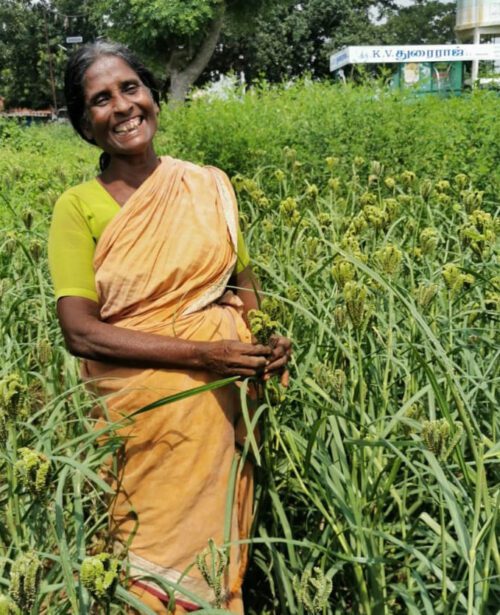Mrs. Arul Mouzhi is a woman farmer living in Kongathiranpatti village who owns three acres of dry land and one acre of irrigated land. Arul and her family eat millet twice a week. She gets her millet and vegetable seeds from Kolunji Ecological Farm and Training Center,an IPAM Field Learning Site managed by Kudumbam. Kolunji facilitates her exchanging seeds with other farmers.
Trained by Kudumbam, Arul is one of the farmers who has changed her methods of cultivating to adapt and mitigate the impacts of climate change on her farm. She grows eight varieties of crops in one of her fields employing the method of mixed cropping. She cultivates ragi, cow-pea, green leaves, maize, kongrura, red and black gram. Most of the harvest crops are for family use and the leaves and husk go to cattle.
Climate change has had a huge impact on her farming and, thus, her livelihood. The last five to eight years have seen harmful effects of severe drought where lack of water results to failure of cultivation from time to time. For Arul’s one-acre irrigated land, she gets water from the tank that also supports the whole village. Since the tank has been empty for a while, she is unable to cultivate her paddy farm.
Arul solved the situation by adopting the mixed cropping system. She explains, “I’ve realised that through mixed cropping, simple crops could be cultivated in dryland around the house, which gives good yield, fodder and supports family nutrition. Those crops have only been here for one season. In mixed cropping, if we fail one crop, the other one will give an income. At least one of them will survive.”
As for soil fertility, she says, “I haven’t been able to cultivate much, but when the cows are here, I make them go to the field. The cow dung and urine waste go directly to the soil, that’s why my field looks good nowadays.”
Since the advent of the Green Revolution in Tamil Nadu in the 60s, the practice of cultivating millet had been ignored and forgotten. Kudumbam taught Arul how to cultivate new seeds. She learned that different types of millet seeds don’t need as much water as paddy. “I shared this to farmers who cultivate hybrid seeds and couldn’t grow without chemical fertilisers. Using traditional methods are more sustainable for humans and the environment. I came to know about millets through Kudumbam. I cultivate finger millet, which my grandson likes to eat as porridge for breakfast,” Arul concludes.
________
Arul is one of the success stories featured in “The Enduring Narratives of Agroecology” by IPAM & PANAP.


